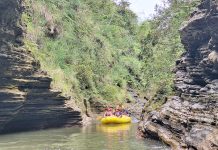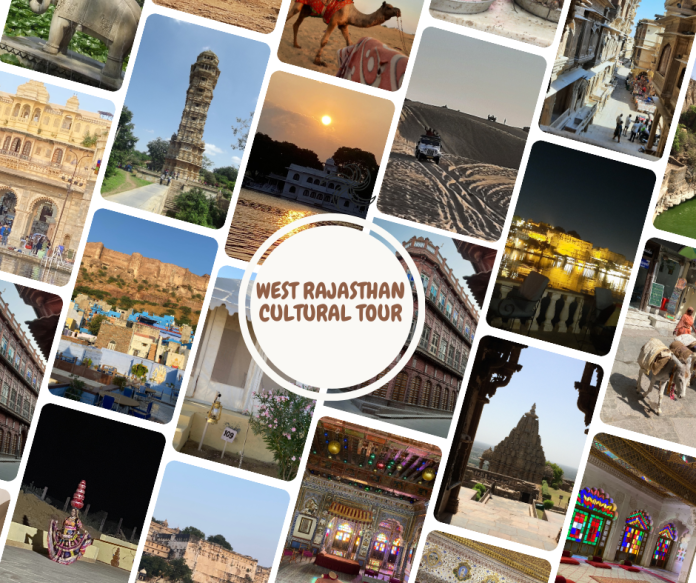
Rajasthan, where history whispers through every stone, is a land of ancient palaces, golden dunes, and sacred temples. A West Rajasthan cultural tour unveils the timeless charm of this desert kingdom, inviting you to experience both tranquility and grandeur.
Having wandered through its palaces and dunes numerous times, I’ve come to appreciate Rajasthan’s beauty. Not just in its famous landmarks, but in quiet moments – like watching the sun set behind a golden fortress.
While Jaipur is often the first stop for visitors, this 8-day itinerary complements a visit to the Pink City by focusing on the quieter, more spiritual, and historically rich destinations of West Rajasthan. Whether you visit Jaipur before or after, this journey will deepen your understanding of the state’s vibrant heritage.
From Jaisalmer’s golden dunes to Udaipur’s tranquil lakes. And from the spiritual heart of Pushkar to the towering fortresses of Chittorgarh and Ajmer, Rajasthan’s ability to captivate will undoubtedly draw you back.
Based on my personal journeys, this comprehensive itinerary highlights Rajasthan’s extraordinary landscapes, remarkable architecture, and sacred sites, ensuring you make the most of your time in this magical region.
Essential Tips for your West Rajasthan Cultural Tour
Before you dive in, here are a few practical considerations to ensure your journey through Rajasthan is as enjoyable and seamless as possible:
- Flexibility: To begin with, flexibility is key to suit your own travel pace or interests. Feel free to adjust it based on the time you want to spend at each location.
- Travel Time: Rajasthan is a large state, and some drives between destinations can be long. Be sure to factor in rest time and enjoy the scenic routes along the way.
- Best Time to Visit: Rajasthan’s climate is best enjoyed from October to March. The weather is cooler and more comfortable for sightseeing.
- Cultural Sensitivity: Many of the places you’ll visit are sacred or culturally significant. Thus, it’s important to respect local customs, especially when visiting temples and religious sites.
- Physical Activity: Some locations, particularly forts and palaces, involve a fair amount of walking and climbing. Consequently, be prepared for moderate physical activity throughout your journey.
Whether you’re captivated by heroic Rajput stories or the temples and ghats’ spiritual serenity, this West Rajasthan cultural tour covers it. Join me on this journey. And together we’ll explore a land full of discoveries at every corner.
Day 1: Start Your West Rajasthan Cultural Tour in Bikaner
Mid-Morning: Unveil the Secrets of Nagaur’s Forgotten Fort
Kick off your West Rajasthan cultural tour with a 235km road trip from Jaipur to Nagaur, a town steeped in history. But often overlooked by tourists. However, the journey is worth it!
The imposing Ahhichatragarh Fort, an architectural masterpiece of sandstone, stands in Nagaur, untouched by time. Wander through its magnificent labyrinth of palaces, courtyards, and intricately carved pavilions. The cool desert breeze carries the faint echoes of history.
Moreover, you’ll feel as though you’ve stepped back into a forgotten era, one where Rajput kings and Mughal emperors once walked the same pathways. It’s easy to get lost here, not just in the maze-like architecture, but in the history that lingers in every stone.
Embrace the Mystique at Karni Mata’s Sacred Rat Temple
Just 90 km from Nagaur, your Rajasthan cultural tour continues to Deshnok, home to the mystical Karni Mata Temple. As you arrive, the temple’s gleaming white marble façade and silver doors might seem traditional. Nevertheless, inside awaits something truly unique: thousands of revered rats, scurrying freely among worshippers.
Locals believe these rats, revered as reincarnations of Karni Mata’s devotees, serve as sacred protectors, and they are treated with deep reverence. As a result, inside, you’ll find devotees offering food and milk to the rats, creating an atmosphere charged with devotion and mystique.
The temple’s carvings tell tales of divine protection and power, while walking barefoot through the temple adds to its otherworldly energy.
Pro Tip: Not keen on walking barefoot among the temple’s furry residents? Pack an old pair of socks for this unusual but unforgettable experience. And don’t worry, locals believe that seeing a white rat is a blessing!
>> RELATED ARTICLE: Discover more about Karni Mata Rat Temple in this comprehensive guide.
Late Afternoon: Wander Through Bikaner’s Old City – Where Time Stands Still
As you wander through Bikaner’s narrow lanes, the scent of incense mingles with the earthy aroma of spices from street vendors. Meanwhile the distant echo of temple bells fills the air. On your Rajasthan cultural tour, venturing into the narrow lanes of Bikaner’s old city feels like stepping into an ancient storybook. Each turn reveals a new tale, none more impressive than the grandeur of the Rampuria Havelis, known as the “Pride of Bikaner.”
These exquisite 19th-century mansions were built by the city’s wealthiest merchants and stand as a testament to their opulence and taste.
Take your time to admire the intricate carvings, red sandstone façades, and jharokhas (overhanging balconies). They reflect the artistic brilliance of a bygone era. Don’t rush – each haveli offers a new perspective on the city’s rich past.
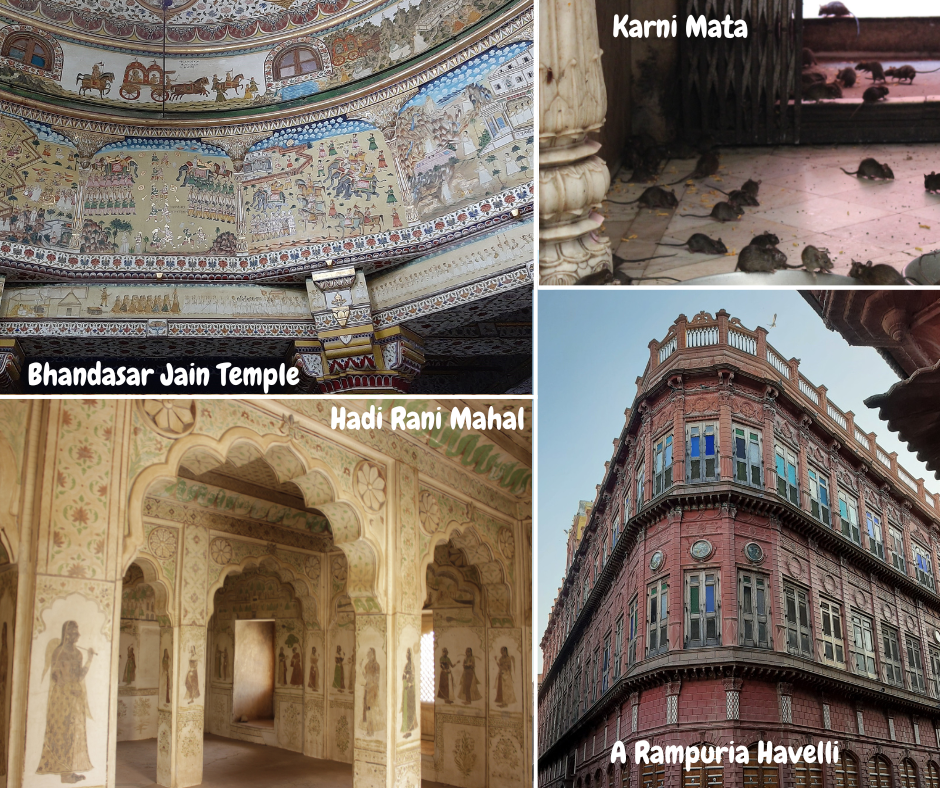
Next, visit the Bhandasar Jain Temple, one of Bikaner’s true hidden gems. This 15th-century marvel, dedicated to the 5th Jain Tirthankara, is adorned with vibrant frescoes, detailed mirror work, and gold-leaf paintings. Legend has it that the temple was built with 40,000 kg of ghee instead of water, making its delicate artistry even more awe-inspiring.
As the day draws to a close, you will end your journey at the Shri Laxminath Temple. Here, the rhythmic chants of the evening aarti fill the air, while the soft glow of oil lamps casts a magical light on the temple’s walls. Ultimately, the serene energy of this sacred space is the perfect conclusion to a day steeped in history and culture.
Where to Stay: Bikaner offers plenty of places to rest. Whether you’re seeking royal grandeur or modern comfort, there’s something for every traveller here. However, a friendly word of advice: Hotel Swagatam is one place you might want to skip!
Day 2: Bikaner to Jaisalmer – Into the Heart of Your West Rajasthan Cultural Tour
Morning: Junagarh Fort – A Testament to Royal Opulence
Start your day at the magnificent Junagarh Fort, one of Rajasthan’s most formidable citadels. Standing proudly since 1588, time and invaders alike have failed to conquer Junagarh Fort. The red sandstone marvel is a rarity among Rajasthan’s forts. As you wander through its palaces, the blend of Rajput and Mughal architecture tells stories of a golden past.
Step into the lavishly adorned Anup Mahal and Phool Mahal. Intricate carvings, gilded ceilings, and vivid frescoes offer a glimpse into royal grandeur. Every corner feels like an invitation to travel back in time, where the halls once echoed with the voices of kings and warriors.
Midday: A Journey Through Shifting Sands
The drive from Bikaner to Jaisalmer stretches for hours. Nevertheless, it’s a journey unlike any other. The vast, barren beauty of the Thar Desert rolls out before you, its golden landscape constantly shifting and changing. Meanwhile, the seemingly endless stretch of road may feel isolating, but it heightens your sense of adventure.
Along the way, you may glimpse nomadic herders moving their flocks or tiny villages seemingly untouched by time. Thus, it’s as if the desert itself has preserved these snapshots of life, making the journey feel like a moving picture of ancient times.
Let the quiet expanses of the desert be a space for reflection. What stories does the desert hold, waiting to be heard as you move toward the golden city of Jaisalmer?
Afternoon: The Golden City Rising on the Horizon
Approaching Jaisalmer, the landscape begins to shift. Rising above the desert, Jaisalmer Fort suddenly breaks the monotony of the golden landscape. It gleams in the afternoon sun like a beacon from the past. It’s like something from a grand film set. The yellow sandstone walls, glowing in the afternoon sun, bathes the city in golden hues.
As a result, it feels almost unreal, like you’ve wandered into a scene from an epic film, where traders and caravans once passed through its gates along the ancient Silk Route. However, for now, resist the temptation to explore the fort’s hidden treasures. You’ll delve into its secrets tomorrow.
Late Afternoon: Desert Adventure and Sweet Dreams
No trip to Jaisalmer is complete without venturing into the heart of the Thar Desert. Just 40 km away, the Sam Sand Dunes await, offering a thrilling adventure amid endless golden waves of sand.
First, embark on an exhilarating 4×4 Jeep ride, as your vehicle climbs and plunges over towering dunes, the wind rushing through your hair.
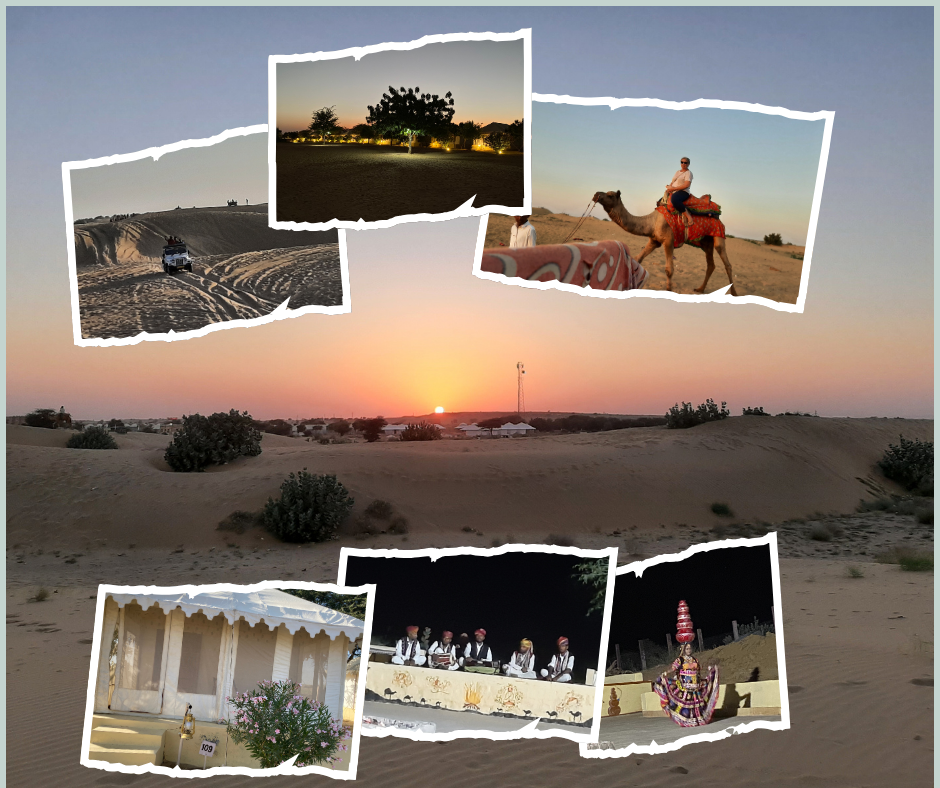
Then, slow the pace and switch to a camel’s rhythmic gait for a more meditative experience. As your camel sways gently beneath you, the desert stretches endlessly in all directions. In the meantime, the only sound being the soft footfall in the sand. With each step, the desert’s stillness seems to grow, and you find yourself lost in its timeless tranquillity.
As the sun sets, a surreal golden glow bathes the dunes, casting long shadows that seem to stretch into eternity. Perched atop a dune, savour the moment – the desert at dusk is an experience that feels both humbling and eternal.
Allow yourself to be fully immersed in the stillness and beauty of the desert, as the sun sets. It’s a moment to carry with you long after you leave the dunes behind.
Evening: Cultural Night at Wind Desert Camp
As night falls, you arrive at Wind Desert Camp, where a night of cultural immersion and Rajasthani hospitality awaits. In the evening, the desert air fills with the rich scent of spices from the traditional Rajasthani feast.
The night comes alive with the sounds of traditional Rajasthani music and dance. Musicians play soulful melodies, while dancers in colourful costumes whirl gracefully around the fire, creating an atmosphere of rhythm, colour, and joy.
Where to Stay: Under the Stars at Wind Desert Camp
After the festivities, retreat to your air-conditioned tent with en-suite for a night under the vast desert sky. The desert’s stillness, punctuated only by the occasional whisper of the wind, creates a sense of calmness. Drift off to sleep beneath a blanket of stars. The Thar Desert’s vastness and the richness of the day’s experiences leave you with a deep connection to this magical place.
Day 3: Explore Jaisalmer on your West Rajasthan Cultural Tour
Today, you have the luxury of taking things at your own pace, immersing yourself in Jaisalmer’s enduring appeal. Begin your day with a leisurely walking tour of Jaisalmer Fort, locally known as Sonar Quila (Golden Fort). This massive sandcastle, rising from the sandy plains like a mirage, is an impressive sight.
Morning: Mysteries of the Haunted Village and Royal Legacies
After a restful night at Wind Desert Camp, your adventure continues with a journey into the unknown. Just 30 km away lies Kuldhara, a deserted village frozen in time. As you walk among the ruins, the eerie silence and crumbling houses paint a haunting picture of abandonment.
Legend whispers that the villagers vanished overnight. Leaving behind only echoes of their lives, and a curse that forbids anyone from settling here again.
Next, leave the mystery behind for a tribute to Rajasthan’s royals at Bada Bagh. Majestic cenotaphs of Jaisalmer’s maharajas rise gracefully from the desert. Domed pavilions, or chhatris, stand in silent tribute to rulers of the past. Each sandstone structure tells its own story, blending seamlessly with the landscape and offering a moment of quiet reflection against the vast desert backdrop.
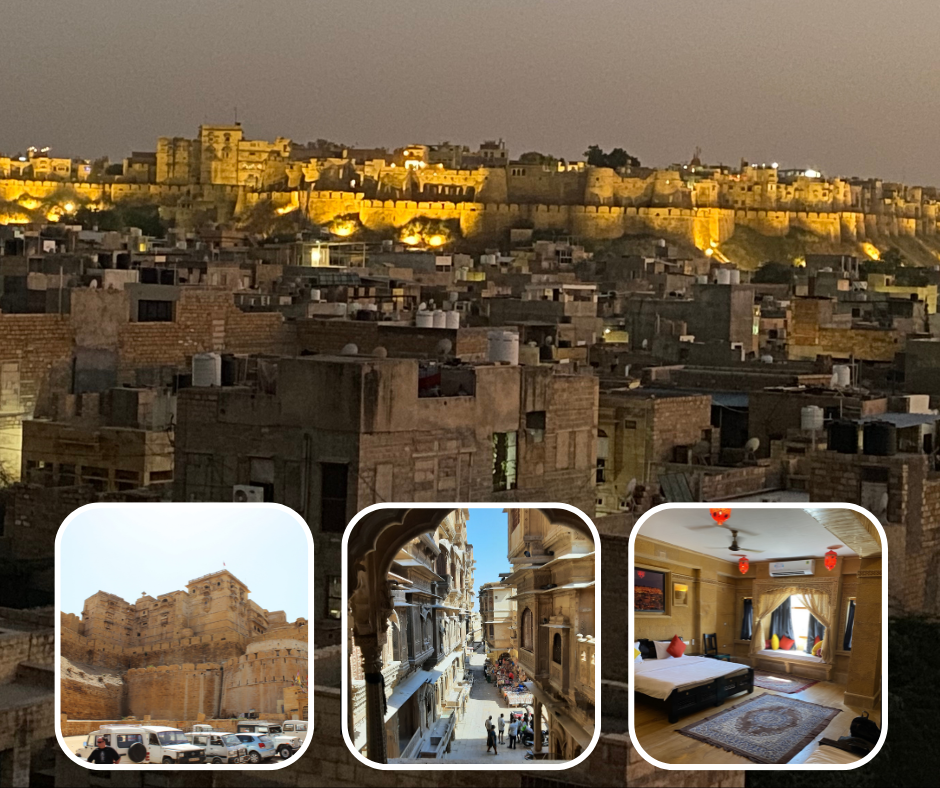
Early Afternoon: In the Shadow of Sandstone – Exploring Jaisalmer’s Rich Heritage
Following lunch, make your way back to Jaisalmer. The midday illuminates the city’s iconic yellow sandstone walls, radiating warmth and brilliance. It’s easy to see why Jaisalmer has earned the title “The Golden City.” Enter through the towering gates of Jaisalmer Fort, a living monument where history breathes alongside modern life. Within its massive walls, bustling markets offer vibrant Rajasthani textiles, while the scent of incense and spices fills the winding alleyways.
As a result, let yourself become lost in this maze of history and culture, where every turn reveals something new. A hidden courtyard, a peaceful shrine, or a centuries-old shop brimming with traditional crafts. Pause for lunch at a rooftop café. Sip hot chai as you take in the sweeping view of golden sandstone blending into the distant desert. It’s a moment of stillness and serenity amidst the city’s lively energy.
Late Afternoon: Spiritual Serenity and Timeless Elegance
As the afternoon sun casts long shadows over the fort, take time to explore the Jain Temples. Peace and artistry fill the Jain Temples. Their ornate details and exquisite stonework showcase the incredible craftsmanship of Jaisalmer’s artisans.
Before the day draws to a close, wander through the city’s havelis – once imposing residences of wealthy merchants. Each haveli is adorned with beautifully carved jharokhas (overhanging balconies) and exquisite facades. They offer a glimpse into Jaisalmer’s opulent past. These architectural gems, nestled within the fort’s winding lanes, hold stories of merchants who thrived during the city’s golden age of trade.
Where to Stay: End your day with dinner on the terrace overlooking the majestic fort at the luxurious Hotel Lal Garh Fort And Palace. Watch as the sun sets, casting its final golden light across the city. Unwind after a day of discovery by soaking in the beauty of the Golden City, with its ancient fort standing proudly against the desert sky.
For more exciting activities and must-see attractions in Jaisalmer, check out this guide to the 7 Things to Do in Jaisalmer.
Day 4: From From the Golden City to the Blue City – Jaisalmer to Jodhpur
Morning: Farewell to Jaisalmer and a Scenic Journey
As you continue your West Rajasthan cultural tour, the desert adventure from Jaisalmer to Jodhpur unveils Rajasthan’s changing landscapes, from golden sands to vibrant blue houses.
The 280 km drive offers a fascinating transition from the muted desert tones to the vibrant blues that await. Along the way, you’ll pass camel caravans and rustic villages, each adding its own chapter to the story of Rajasthan’s rich cultural heritage.
As the terrain begins to shift and the desert gives way to the iconic indigo hues of Jodhpur’s cityscape, anticipation builds. Known for its stunning, blue-painted houses, Jodhpur offers a visual feast like no other – a striking contrast against the rugged desert landscape.
Late Morning: The Blue Tapestry of Jodhpur – A View from Mehrangarh Fort
Upon arriving in Jodhpur, the first thing that grabs your attention is the imposing Mehrangarh Fort, perched high above the city. On the other hand, as you look down from its ramparts, Jodhpur’s true magic comes into view: a sea of indigo rooftops stretching out beneath you. This is why it’s called the “Blue City”. The blue-washed homes beneath the desert sun create a dazzling spectacle, casting an almost mystical glow over the streets below.
As you explore the fort, its grandeur is complemented by the panoramic view of Jodhpur’s blue-hued neighbourhoods. The tradition of painting homes in shades of blue started centuries ago, originally as a way to signify the homes of Brahmins. But over time, it spread throughout the city. Today, the colour is not only symbolic. It also serves a practical purpose, helping to keep homes cool in the desert heat.
From your vantage point atop Mehrangarh, imagine the endless stretch of indigo roofs beneath you. Each one part of the vibrant tapestry that gives Jodhpur its famous moniker.
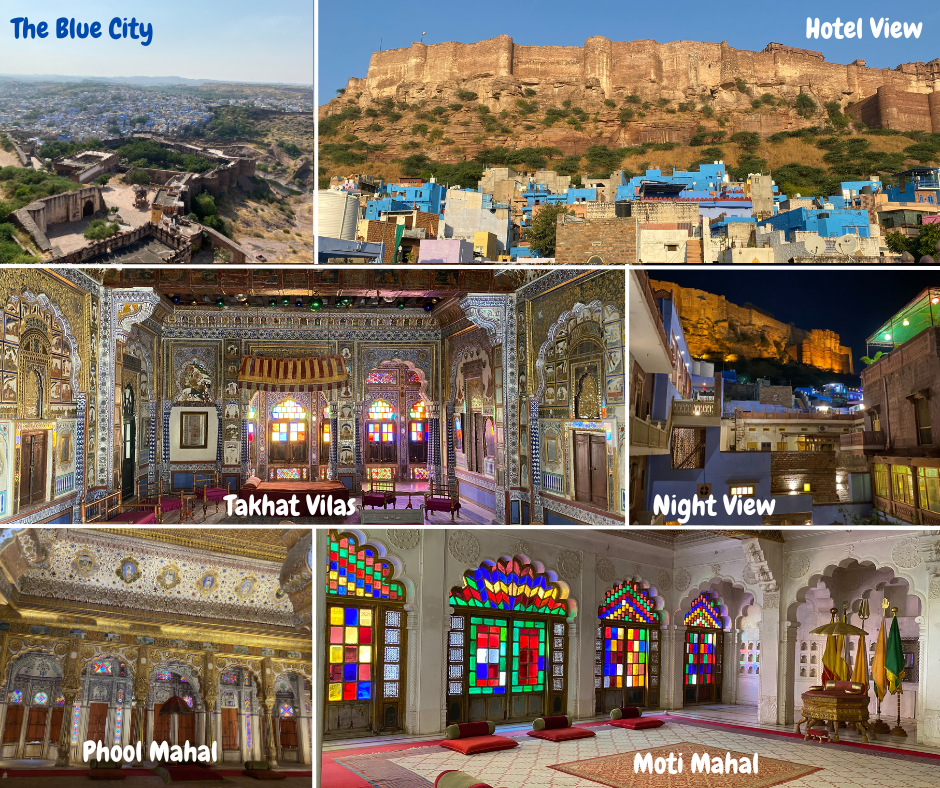
Early Afternoon: Discovering the Blue City’s Regal Legacy
Opposite, just a short walk from the fort, you’ll visit Jaswant Thada, a peaceful marble cenotaph known for its beauty and serenity. While the white marble glows in the sun, the backdrop remains the blue cityscape, offering a stunning contrast that enhances the visual magic of Jodhpur.
It’s a perfect spot to pause and reflect on the city’s royal heritage while taking in the unique blend of colours surrounding you.
Late Afternoon: Royal Opulence and Blue Horizons
Your journey continues with a visit to the grand Umaid Bhawan Palace, one of the world’s largest private residences. While the opulence of the palace will impress, it’s hard not to be drawn back to the sprawling blue city beneath the palace grounds.
The blue tones seem to fade into the horizon, creating an almost dreamlike view. The palace itself is a marvel, but the view of the indigo-painted houses from here truly showcases why Jodhpur stands out among Rajasthan’s cities.
Evening: Indigo Evening – A Stroll Through Jodhpur’s Local Life
As the day winds down, immerse yourself in the heart of Jodhpur’s Old City. The Clock Tower and Sadar Market form the lively centre, but what makes this area truly special is the network of narrow streets lined with blue-washed homes.
These streets are filled with local life. Vendors selling everything from vibrant textiles to fragrant spices, artisans at work, and families go about their daily routines. Walking through these winding alleys, you’re surrounded by the brilliant blue facades that give Jodhpur its unique identity.
Take time to visit the remarkable Toorji ka Jhalra, an ancient stepwell, where even the worn stone steps are tinged with shades of blue from centuries of city life. As you descend into its depths, the stepwell’s geometry reflects the structured beauty of Jodhpur, where even water management systems are an artistic marvel.
As the sun sets and the blue-painted homes deepen in hue, you’ll experience the charm of Jodhpur at twilight. Where the blue city truly feels like something out of a dream.
Where to Stay: For an authentic stay in Jodhpur, Krishna Prakash Heritage Haveli blends traditional Rajasthani architecture and modern comfort. With spacious rooms, intricate decor, and stunning rooftop views of Mehrangarh Fort, it’s an ideal stopover for your West Rajasthan cultural tour.
Day 5: Blue Skies, Marble Temples, and Majestic Forts – An Epic Journey to Udaipur
Morning: From Blue to Green – A Picturesque Journey from Jodhpur to Ranakpur
Start your day early as you leave behind the vibrant streets of Jodhpur and head towards Ranakpur, nestled in the peaceful Aravalli Hills. The 160 km journey takes about 2.5 hours, passing through rural Rajasthan’s rugged landscape. Along the way, you’ll catch glimpses of village life, with colourful houses, traditional farming scenes, and, if you’re lucky, a camel caravan slowly making its way across the desert.
The drive itself is part of the adventure, offering a tranquil contrast to the bustling energy of Jodhpur. Gradually, as the hills begin to rise around you, the serenity of the journey sets the perfect tone for your visit to Ranakpur.
Late Morning: Whispers of Tranquility – Deep Dive into Ranakpur’s Jain Masterpiece
The awe-inspiring sight of white marble and intricate carvings greets you at Ranakpur Jain Temple. Built in the 15th century from white marble, the masterpiece of intricate design has over 1,400 pillars. Each one is uniquely carved with delicate details.
Take your time as you wander through its peaceful halls, letting the serenity of the place wash over you. The temple’s atmosphere invites reflection, with sunlight filtering softly through the marble, creating a sense of timeless calm. Whether you’re drawn to its religious significance or the sheer brilliance of its architecture, Ranakpur is an unforgettable stop on your journey.
Insider Tip: Don’t forget to look up. The ceilings and domes are adorned with some of the temple’s most elaborate carvings.
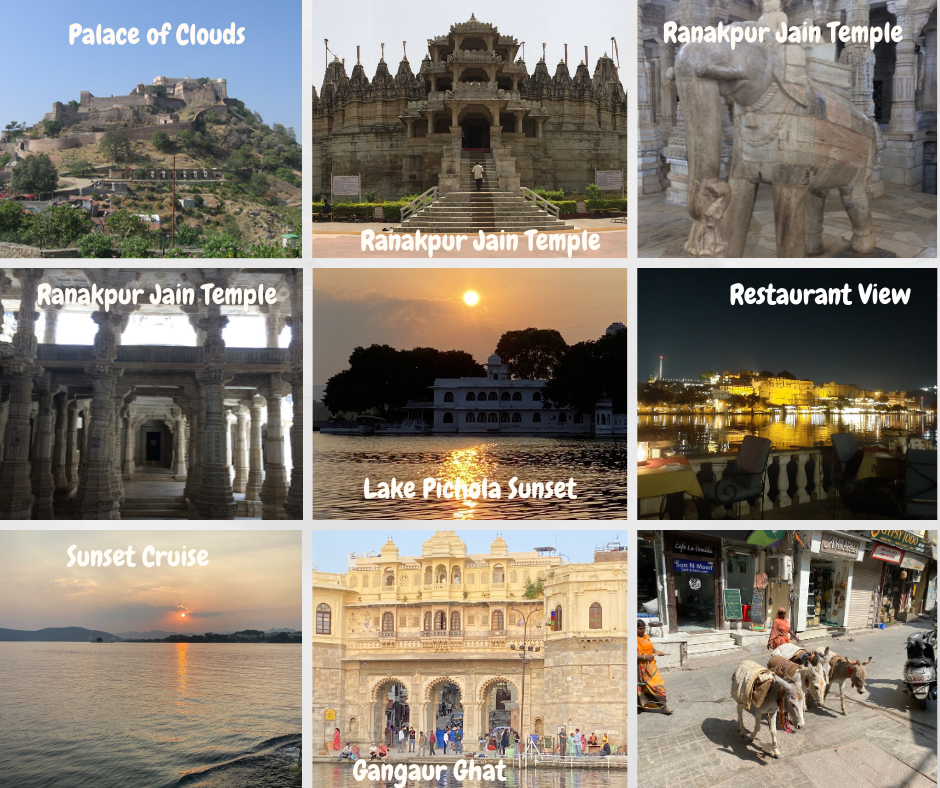
Midday: Kumbhalgarh Fort – A Sprawling Fortress with 36 km of Walls and 360-Degree Views
Kumbhalgarh Fort is an hour and a half’s drive from Ranakpur. Along the way, you’ll wind through the lush, hilly terrain of the Aravalli Range, offering dramatic vistas at every turn. Approach the fort, the scenery becomes more dramatic, with Kumbhalgarh rising like a sentinel above the landscape.
Built by Rana Kumbha in the 15th century, Kumbhalgarh Fort is a UNESCO World Heritage Site. And one of Rajasthan’s most formidable structures. Interestingly, its walls stretch for an astonishing 36kms – second only to the Great Wall of China. Inside the fort, you’ll discover a vast complex of temples, palaces, and ancient buildings. As you walk through the towering gates and explore its expansive courtyards, you’ll be transported to an era of kings and warriors.
Don’t miss a visit to Badal Mahal, or the “Palace of Clouds,” where you’ll be treated to sweeping views of the surrounding countryside. At 1,100 meters above sea level, the panoramic vistas are nothing short of extraordinary, with the hills and valleys unfolding before you like a painting.
Late Afternoon: Arriving in Udaipur, the Venice of the East
After lunch, continue your journey to Udaipur, the “City of Lakes.” The 85 km drive takes about 2 hours, weaving through more of Rajasthan’s picturesque hill country. Eventually, descending from the heights of Kumbhalgarh, the scenery begins to soften. The promise of Udaipur’s shimmering lakes and palaces beckons in the distance.
Lakes flicker in the golden light, and Udaipur’s iconic palaces come into view. Their white facades reflect off the tranquil waters. There’s an undeniable romance to Udaipur, making it the perfect end to your day’s adventure.
Evening: A City of Romance and Reflections
Upon arriving in Udaipur, check into your hotel and take some time to relax before setting out for an enchanting evening by the water. Meanwhile, a stroll along the banks of Lake Pichola is the perfect way to unwind. The tranquil lake is framed by the magnificent City Palace on one side and the elegant Jag Mandir in the centre, both of which glow softly in the fading light.
With the sun setting, take a boat ride across the shimmering lake, where palace and ghat reflections create an almost fairy-tale scenes. The water’s stillness, combined with the surrounding architecture’s grandeur, offers a peaceful way to experience Udaipur’s beauty.
Insider Tip: If time permits, explore Udaipur’s bustling markets before heading to dinner. Specifically, from vibrant textiles to intricate jewellery, these markets are a treasure trove of local craftsmanship. Take home a piece of Rajasthan’s artistic heritage.
For dinner I recommend Ambrai Restaurant. Dine under the stars while enjoying views of the City Palace illuminated against the night sky. The combination of traditional cuisine, warm evening air, and glowing reflections on the lake will leave you with a memorable dining experience.
Where to Stay: Jagat Niwas Palace provides an extraordinary blend of history and luxury. Set in a 17th-century haveli, this heritage hotel perches right on Lake Pichola’s edge. Dazzling views of the City Palace, Lake Palace, and Aravalli Hills add to its luxury.
Day 6: Unwind in The City of Lakes
Morning: A Quiet Breakfast Overlooking Lake Pichola
Enjoy a peaceful breakfast by Lake Pichola, taking in views of the Jag Mandir Palace. As you sip your morning tea or coffee, let your gaze linger on the Jag Mandir Palace, which seems to float effortlessly in the lake’s centre.
The City Palace casts its grand reflection across the calm waters, while the gentle breeze carries the scent of the surrounding gardens. As a result, the soft morning light dancing on the water creates a moment of pure tranquillity, setting the perfect tone for your day.
Mid-Morning: Temple Bells to Panoramic Peaks
After breakfast, take a short walk to the Jagdish Temple, a stunning example of 17th-century Hindu architecture. Artisans intricately carved the temple’s stone façade with elephants and delicate sculptures that tell stories of ancient legends. Subsequently, step inside, and the rhythmic chants of devotees and the sound of temple bells reverberate through the halls, enveloping you in a peaceful atmosphere.
Next, ascend to the Monsoon Palace, perched high above Udaipur on the Bansdara Peak. Originally built as a royal retreat for astronomical observation, the palace offers a commanding view of the lakes and the Aravalli Hills.
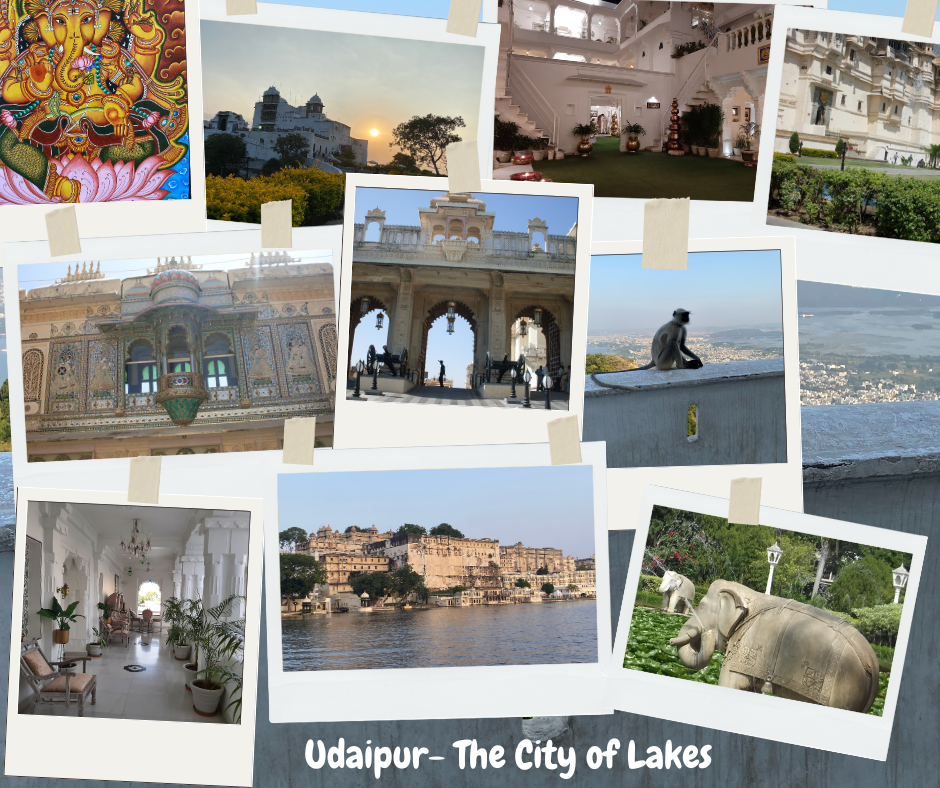
The scenic drive winds through lush landscapes. At the summit, you’ll be rewarded with expansive views of Udaipur and its surrounding countryside. The Monsoon Palace is also a fantastic spot for photography, with the city’s lakes shimmering below and the hills stretching out to the horizon.
Stand at the edge of the palace, looking out over the sweeping landscape. Then imagine how the royals once used this vantage point to track the movement of the monsoon clouds.
Afternoon: City Palace – Crown Jewels of Royalty
Spend your afternoon immersed in Udaipur’s royal heritage with a visit to the sprawling City Palace, a symbol of opulence and history. This regal complex, built over 400 years by various rulers, is an architectural masterpiece that blends Mughal and Rajasthani styles.
As you wander through its ornate corridors, take in the dazzling mosaic work, intricate stained-glass windows, and elaborate murals that adorn the walls. Mor Chowk’s (Peacock Courtyard) impeccably detailed mosaic peacocks shimmer in the sunlight. Each tile a testament to the artisans’ craftsmanship.
In the Zenana Mahal, once the queens’ private quarters, the grandeur of royal life is on full display. Lavish decor to elaborately carved balconies overlook the inner courtyards. The City Palace Museum houses an impressive collection of artifacts, offering insights into the regal lifestyle of the Mewar dynasty.
Insider Tip: Take time to linger on the palace’s terraces. Sweeping views of Lake Pichola and the city below will unfold before you. The vantage point offers iconic photo opportunities.
Late Afternoon: Udaipur Heritage at Bagore Ki Haveli
Before the day winds down, visit Bagore Ki Haveli, a beautifully restored 18th-century mansion located at Gangaur Ghat. This architectural gem offers an intimate glimpse into Udaipur’s past, with over 100 rooms showcasing royal costumes, intricate glasswork, and traditional Rajasthani crafts.
Udaipur’s nobles once resided in the haveli’s elegant rooms, which are still decorated with vibrant frescoes and fine furnishings. Wander through the courtyard. The gentle sound of water flowing from the fountains creates a peaceful retreat from Udaipur’s bustling streets outside.
Where to Stay: Jagat Niwas Palace – one of the hotel’s highlights is its rooftop terrace restaurant. Enjoy a candlelit dinner while gazing out at the illuminated palaces on the lake. The tranquil atmosphere and impeccable service make Jagat Niwas Palace more than just a place to stay.
Day 7: Battlegrounds and Blessings – Exploring Chittorgarh’s Heroism and Pushkar’s Spiritual Serenity
Morning: Udaipur to Chittorgarh’s Legendary Past
To start, begin your day with an early departure from Udaipur, setting off for the legendary city of Chittorgarh. As you drive through the rolling hills of the Aravalli range, the scenic landscape offers glimpses of rural Rajasthan. Watch as farmers tend to their fields, and the morning sun casts a golden hue over the countryside.
The 2-hour drive provides a peaceful start to your journey, gradually immersing you in the history and beauty of Rajasthan’s heartland.
Mid-Morning: Discover the Majestic Chittorgarh Fort
Upon arrival in Chittorgarh, you’ll be greeted by the imposing Chittorgarh Fort, a UNESCO World Heritage Site. And the largest fort in India. Spanning over 700 acres, this grand fortress is a living monument to Rajput bravery and the site of countless battles and acts of heroism.
Begin by climbing the Victory Tower (Vijay Stambh), a towering structure that offers a bird’s-eye view of the fort and surrounding plains. Its intricate carvings tell stories of valour and victory, making it must-see. Next, marvel at the Kirti Stambh, a Jain tower dedicated to Adinath, the first Jain Tirthankara. This masterpiece of ancient craftsmanship, adorned with detailed carvings, reflects the rich cultural diversity of the region.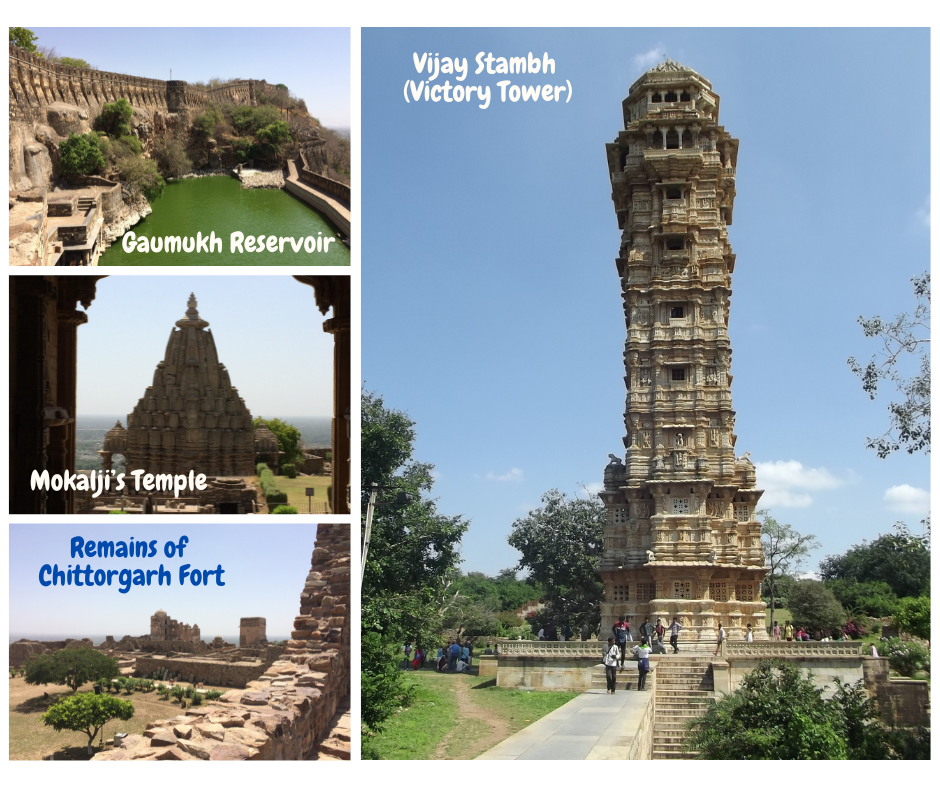
On Day 7 of the West Rajasthan cultural tour, explore the heroic history of Chittorgarh Fort before journeying to the spiritual haven of PushkarDon’t miss Padmini Palace, the residence of Queen Padmini. Her legendary beauty and courage led to one of the most tragic conflicts in Rajput history. Lastly, visit Gaumukh Reservoir. The sacred water tank is believed to hold mythological importance and provides a tranquil opportunity to reflect within the fort’s imposing grounds.
Early Afternoon: Pilgrimage to the Spiritual Heart of Pushkar
After exploring Chittorgarh, enjoy a leisurely lunch before departing for Pushkar. Notably, the 4-hour drive takes you through Rajasthan’s diverse landscapes, from rugged hills to the charming villages that dot the countryside.
Along the way, you might catch sight of vibrant roadside stalls, herds of goats crossing the road, or farmers tending their fields—a true glimpse of rural life.
Evening: Spiritual Calm at Pushkar’s Sacred Ghats
Arrive in Pushkar by early evening, where the town’s peaceful aura greets you. After checking into your hotel, head to the serene Pushkar Lake, the spiritual heart of the town, surrounded by 52 sacred ghats. As the sun begins to set, the lake’s waters take on a golden glow, and the soft chants of the evening aarti fill the air.
Join the pilgrims as they light lamps and place them gently on the water, watching them float across the lake as the prayers echo around you. This peaceful ceremony is a beautiful way to unwind after your journey, offering a peaceful moment to pause and connect.
Late Evening: Nightfall at Bustling Markets
As the night unfolds, stroll through Pushkar’s lively market, a treasure trove of local craftsmanship. The market’s narrow lanes are filled with vibrant stalls offering silver jewellery, colourful textiles, and intricate handicrafts. Whether you’re looking for souvenirs or simply soaking in the energy of this small town, Pushkar’s market is a shopper’s paradise.
Insider Tip: Be sure to haggle politely. It’s part of the local culture. And keep an eye out for unique items like handmade leather goods and traditional Rajasthani embroidery.
Where to Stay: Pushkar offers a range of accommodations, from charming guesthouses to heritage hotels. Opt for a stay in a traditional haveli to fully experience the town’s rich heritage and culture. Alternatively, choose a comfortable guesthouse near the ghats for easy access to the lake.
Day 8: Holy Waters to Historic Landmarks – Discovering Pushkar and Ajmer’s Spiritual Legacy
Early Morning: A Spiritual Start in Pushkar
Begin your morning in Pushkar with a visit to the Jagatpita Brahma Temple. It’s one of the few temples in the world dedicated to Lord Brahma, the creator of the universe in Hindu mythology.
As a sacred pilgrimage site, the temple draws worshippers from across India who come to offer prayers at this revered location. Legend has it that Brahma performed a yagna (ritual) here, giving birth to the universe.
Afterward, make your way to Pushkar Lake, believed to have been formed where Brahma’s lotus flower fell. Stroll around its 52 ghats, where pilgrims bathe in the holy waters, believed to cleanse one’s sins. The calm of the early morning, punctuated by the gentle chants of prayers and the sight of temple bells ringing in the distance, creates a serene and spiritual atmosphere.
Mid-Morning: Leave Pushkar for the Spiritual Depths of Ajmer
For a final panoramic view of Pushkar, visit the Man Mahal, a former royal residence. The reflective surface of the lake, with the temples mirrored upon it, offers a scene that feels almost otherworldly. Use this opportunity to absorb the tranquil beauty of this sacred town.
From Pushkar, embark on a short 30-minute drive to Ajmer, a city with deep spiritual roots and historical significance. The drive offers views of Rajasthan’s rugged landscape, with the Aravalli Hills as a constant companion.
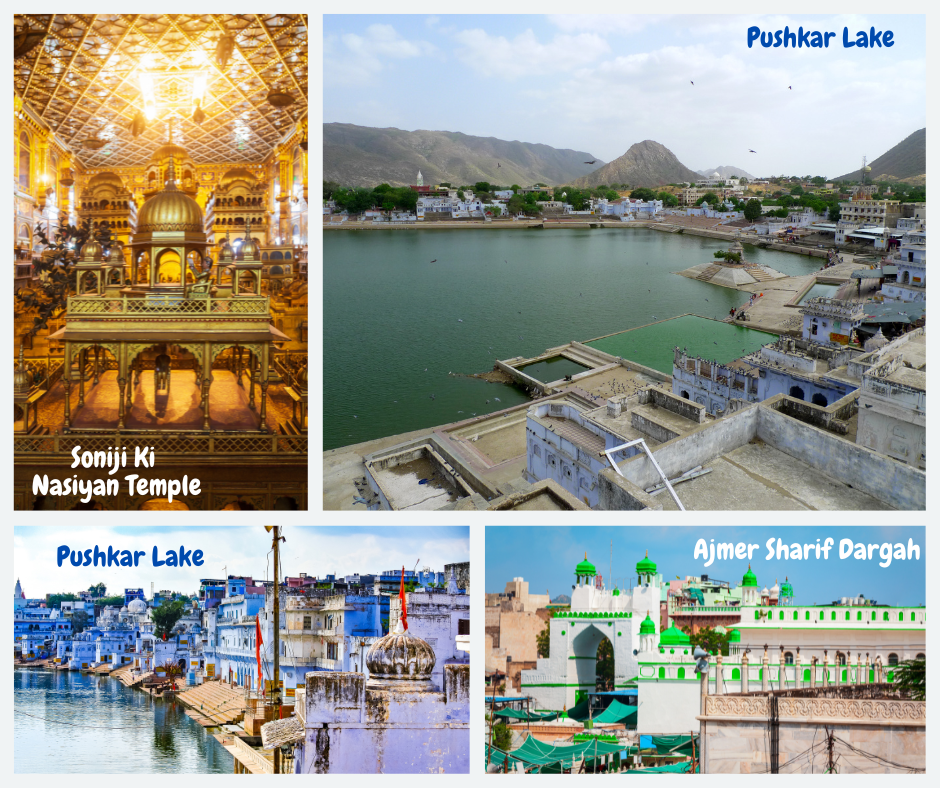
Late Morning: Experience the Sacred Aura of Ajmer Sharif Dargah
Your first stop in Ajmer is the iconic Ajmer Sharif Dargah, a major pilgrimage site for followers of Sufism and Islam. Dedicated to the revered Sufi saint Khwaja Moinuddin Chishti, this holy sanctuary exudes a deep sense of peace and devotion. As you approach the Nizam Gate, the entrance to the shrine, the air is filled with the sounds of prayers and the soft hum of devotees offering their respects.
Inside the dargah complex, pilgrims gather at the Maqbara, the tomb of Khwaja Moinuddin Chishti, to seek blessings. Shahjahani Gate, a remarkably crafted architectural structure commissioned by Emperor Shah Jahan, reflects the elegance of Mughal design.
The dargah is not only a spiritual centre but an architectural wonder. Centuries of devotion and prayer have its walls.
Afternoon: Discover Ajmer’s Historical Treasures
After visiting the dargah, take time to explore Akbar’s Palace, built in 1570 to house the emperor and his troops during visits to the dargah. Today, it functions as a museum showcasing an impressive collection of Mughal-era weapons, sculptures, and paintings. The museum offers a glimpse into the artistic and military achievements of the Mughal Empire, including a striking black marble statue of Goddess Kali.
Additionally, for a different cultural experience, visit the Soniji Ki Nasiyan Temple. The stunning Jain temple is revered for its Swarna Nagari (City of Gold). The gold-plated chamber depicts the Jain concept of the universe. More than 1,000 kilograms of gold has been used to create an awe-inspiring spectacle.
Late Afternoon: Scenic Return to Jaipur Through the Aravallis
In the late afternoon, conclude your West Rajasthan cultural tour with a scenic 2.5-hour drive back to Jaipur through the picturesque Aravalli Hills.
As the journey winds through the rugged landscape, it’s the perfect time to reflect on the rich cultural heritage and unforgettable experiences you’ve encountered throughout your tour, from majestic forts to serene temples
Closing Thoughts: Your Journey Through Rajasthan’s Timeless Legacy
As you prepare to embark on this journey through Rajasthan, you’ll soon experience the essence of this remarkable state. From its heroic tales and majestic palaces to its sacred temples and serene lakes.
My 8-day West Rajasthan cultural tour itinerary is designed to give you a deeper connection to Rajasthan’s rich heritage. It allows you to explore not only its majestic landmarks but also the quieter moments. These are the experiences that reveal the true soul of this land.
While I cover some of Rajasthan’s most iconic destinations, the trip’s magic lies in the unexpected discoveries along the way. Whether it’s a chance conversation with locals, a fort’s hidden corner, or the stillness of a desert sunset. Rajasthan is a place where history, culture, and spirituality combine, and each day will bring something new and awe-inspiring.
So pack your bags and embrace the call of the desert winds. Let this West Rajasthan cultural tour take you on a journey through time. One that will leave you enchanted, inspired, and eager to return. Rajasthan is not just a place. It’s an experience that stays with you long after you’ve left. The colours, the stories, the warmth of its people. Everything beckons you to return, again and again, to discover more.

